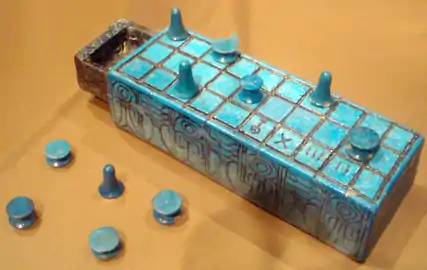Game piece (hieroglyph)
The ancient Egyptian Game piece (hieroglyph), also a Token, or the general term for any gaming-gambling piece, Draughtsman is an ancient hieroglyph. Gaming pieces were certainly required in predynastic times, as the cultural creation of games and entertainment has a long history in most cultures. An ivory-piece lion is known from the Old Kingdom of ancient Egypt; the set contains three lions, and three dog tokens of ivory.[1][2]
| Game piece "Token" in hieroglyphs | ||
|---|---|---|
| Draughtsman in hieroglyphs | ||||
|---|---|---|---|---|
The Senet is recorded as the oldest boardgame in history, for which tokens are used.
Use of the "game piece" hieroglyph
| To Dance" [of the god] (2 plurals, 1 chick, 3 tokens) in hieroglyphs | ||||||||||
|---|---|---|---|---|---|---|---|---|---|---|
The basic word for "Game piece" or "Draughtsman" is "ab". By implication, people on a flat arena were moving like "pieces" (from a distance), and numerous varieties of the word 'to dance' include varieties using the "Game piece", as a determinative; two examples are shown: the word 'draughtsman', and 'to dance'-(the plural of "ab", "abU"-(U being the language plural-but also the "quail chick (hieroglyph)" in Ancient Egypt).
Iconographic use
The most common use of the "Gaming piece" as an artefact of ancient Egypt, would be the use with the game of Senet. The Senet game was often put into tombs and grave sites, as part of the grave goods; the games were part of the pastimes for the afterlife, including any other common 'hobbies' of the deceased–(for example hunting ducks at the marsh using a throwstick). Since board games represent the common man's activities, the Senet game has numerous examples from Ancient Egypt; this also includes the reliefs shown on temple walls, of individuals enjoying their activities in the afterlife.
Example "gaming tokens"
Some example game pieces of ancient Egypt. One of the more famous games was "Hounds and Jackals", a race game, with far less artefacts found of the game.


 Gamepieces and board
Gamepieces and board Old Kingdom gaming piece of ivory. Set of 6, 3 lions, and 3 bulldogs; Abu Rouash, Tomb M, 1st Dynasty, 3.5 × 6.5 cm, Cairo Museum[4]
Old Kingdom gaming piece of ivory. Set of 6, 3 lions, and 3 bulldogs; Abu Rouash, Tomb M, 1st Dynasty, 3.5 × 6.5 cm, Cairo Museum[4]
References
- Schulz, Seidel, 1998, chapter: The Rise of the State to the Second Dynasty, author, Stephan Seidlmayer, p. 35.
- Lion token, Wikimedia Commons
- Metropolitan Museum of Art photo, (with excessive blue tint).
- cf. Schulz, Seidel, 1998. Egypt: The World of the Pharaohs, pg. 35.
- Budge, 1920, (1978). An Egyptian Hieroglyphic Dictionary, E.A.Wallace Budge, (Dover Publications), c 1978, (c 1920), Dover edition, 1978. (In two volumes) (softcover, ISBN 0-486-23615-3)
- Schulz, Seidel, 1998. Egypt: The World of the Pharaohs, Editors, Regine Schulz, Matthias Seidel, Könemann Verlagsgesellschaft mbH, Cologne, English translation version. (hardcover, ISBN 3-89508-913-3)